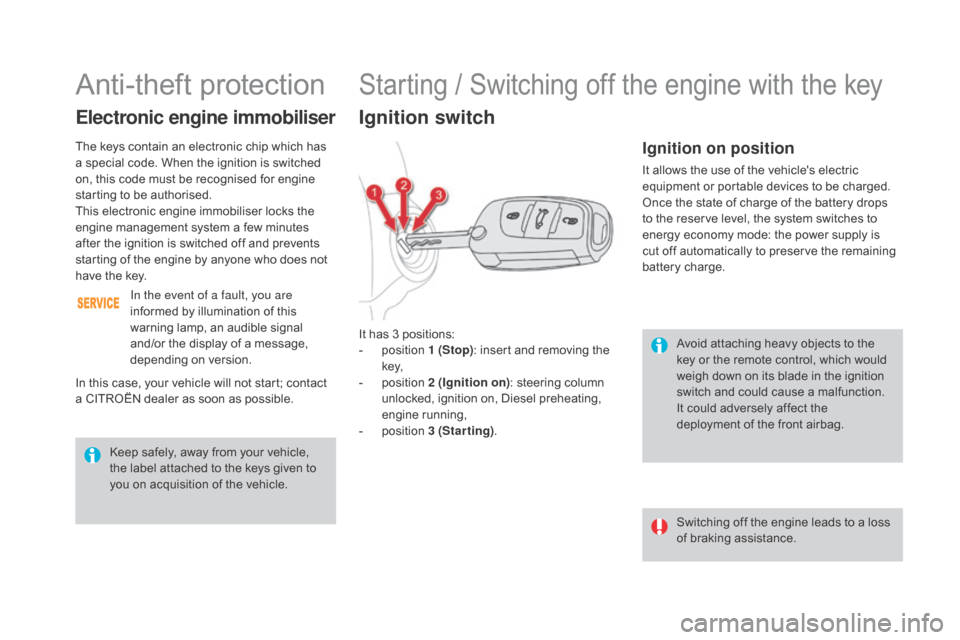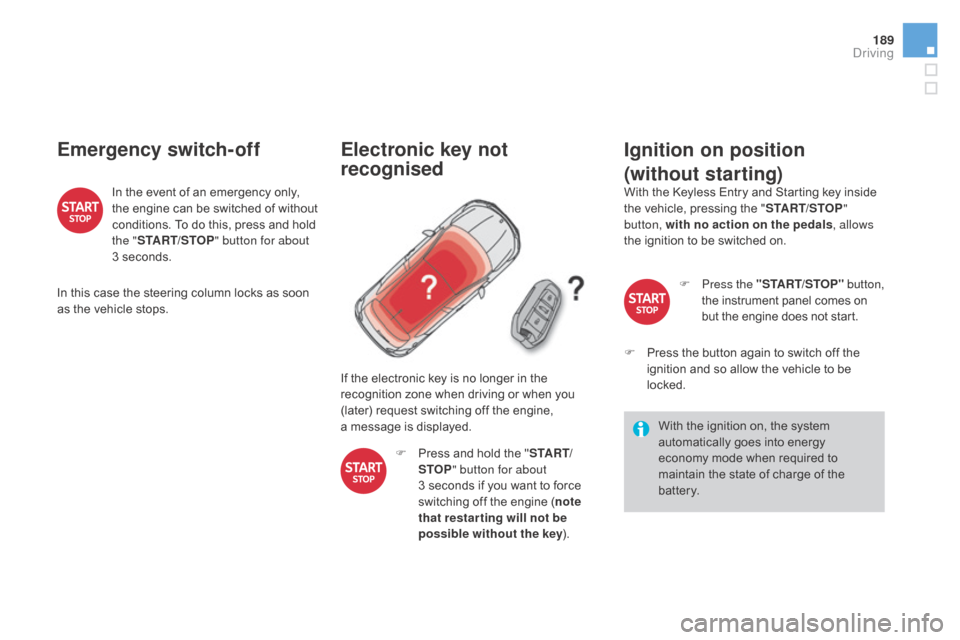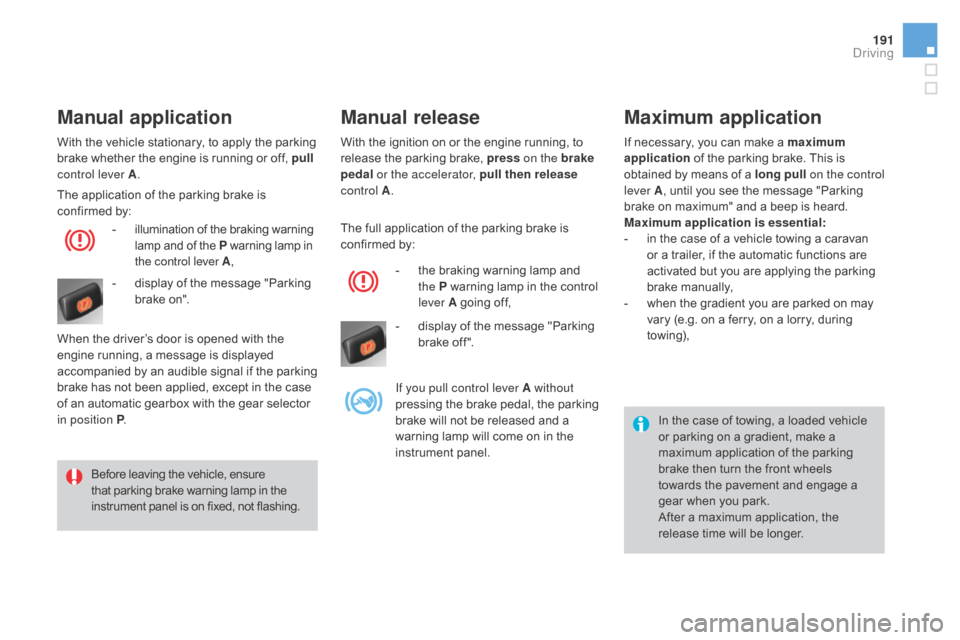ignition Citroen DS4 RHD 2015.5 1.G Workshop Manual
[x] Cancel search | Manufacturer: CITROEN, Model Year: 2015.5, Model line: DS4 RHD, Model: Citroen DS4 RHD 2015.5 1.GPages: 436, PDF Size: 10.13 MB
Page 186 of 436

Avoid attaching heavy objects to the
key or the remote control, which would
weigh down on its blade in the ignition
switch and could cause a malfunction.
It could adversely affect the
deployment of the front airbag.
Starting / Switching off the engine with the key
It has 3 positions:
- p osition 1 (Stop) : insert and removing the
key,
-
p
osition 2 (Ignition on) : steering column
unlocked, ignition on, Diesel preheating,
engine running,
-
p
osition 3 (Starting) .
Ignition switch
Ignition on position
It allows the use of the vehicle's electric
equipment or portable devices to be charged.
Once the state of charge of the battery drops
to the reserve level, the system switches to
energy economy mode: the power supply is
cut off automatically to preserve the remaining
battery charge.
Switching off the engine leads to a loss
of braking assistance.
Anti-theft protection
Electronic engine immobiliser
In the event of a fault, you are
informed by illumination of this
warning lamp, an audible signal
and/or the display of a message,
depending on version.
Keep safely, away from your vehicle,
the label attached to the keys given to
you on acquisition of the vehicle.
In this case, your vehicle will not start; contact
a CITROËN dealer as soon as possible. The keys contain an electronic chip which has
a special code. When the ignition is switched
on, this code must be recognised for engine
starting to be authorised.
This electronic engine immobiliser locks the
engine management system a few minutes
after the ignition is switched off and prevents
starting of the engine by anyone who does not
have the key.
Page 187 of 436

185
In wintry conditions, the warning lamp
can stay on for a longer period. When
the engine is hot, the warning lamp
does not come on.
In certain cases, you may have to apply
more force to the steering (wheels on
full lock, for example). If the engine does not start straight
away, switch off the ignition. Wait a
few moments before operating the
starter motor again. If the engine does
not start after several attempts, do not
keep trying: you risk damaging the
starter motor or the engine. Contact
a CITROËN dealer or a qualified
workshop.In temperate conditions, do not leave
the engine at idle to warm up but move
off straight away and drive at moderate
speed.
Never leave the engine running in
an enclosed area without adequate
ventilation: internal combustion
engines emit toxic exhaust gases,
such as carbon monoxide. Danger of
intoxication and death!
In very severe wintry conditions
(temperatures below -23°C), to ensure
the correct operation and durability of
the mechanical components of your
vehicle, engine and gearbox, it is
necessary to leave the engine running
for 4 minutes before moving off.
Starting the engine
With the parking brake applied and the gearbox
in neutral or position
n or P:
F
d
epress the clutch pedal fully (manual
gearbox),
or
F
p
ress the brake pedal firmly (automatic
gearbox),
F
i
nsert the key into the ignition switch;
the
system recognises the code,
F
unlock the steering column by simultaneously
turning the steering and the key.
F With a petrol engine, operate the starter motor by turning the key to position 3
without pressing the accelerator pedal,
until the engine starts. Once the engine is
running, release the key.
F
W
ith a Diesel engine, turn the key to
position 2 , ignition on, to operate the
engine pre-heating system.
Wait until this warning lamp goes off in the
instrument panel then operate the starter
motor by turning the key to position
3
without pressing the accelerator pedal,
until the engine starts. Once the engine is
running, release the key.
driving
Page 188 of 436

Key left in the "Ignition on"
position
If the key has been left in the ignition switch
at position 2 (Ignition on), the ignition will
be switched off automatically after one hour.
To switch the ignition back on, turn the
key to position 1 (Stop) , then back to
position
2
(Ignition on) .
F Stop the vehicle.
F
W ith the engine running at idle, turn the key
to position 1 .
F
R
emove the key from the ignition switch.
F
T
o lock the steering column, turn the
steering until it locks.
Switching off the engine
To facilitate unlocking of the steering
column, it is recommended that the
wheels be returned to the straight ahead
position before switching off the engine.
When you leave the vehicle, keep the
key with you and lock the vehicle.
For more information, refer to the
"Practical information" section, under
"Energy economy mode".
Never switch off the ignition before the
vehicle is at a complete stop. With the
engine off, the braking and steering
assistance systems are also cut off:
risk of loss of control of the vehicle.
Energy economy mode
After switching off the engine (position 1- Stop
),
for a maximum of 30 minutes you can still use
functions such as the audio and telematic
system, the wipers, dipped beam headlamps,
courtesy lamps,
...
F
C
heck that the parking brake is correctly
applied, particularly on sloping ground.
Page 191 of 436

189
Emergency switch-off
In the event of an emergency only,
the engine can be switched of without
conditions. To do this, press and hold
the "START/STOP " button for about
3 seconds.
In this case the steering column locks as soon
as the vehicle stops.
Electronic key not
recognised
If the electronic key is no longer in the
recognition zone when driving or when you
(later) request switching off the engine,
a
message is displayed. F
P
ress and hold the " S TA R T/
STOP " button for about
3
seconds if you want to force
switching off the engine ( note
that restar ting will not be
possible without the key ).
Ignition on position
(without starting)
With the Keyless Entry and Starting key inside
the vehicle, pressing the "START/STOP"
button, with no action on the pedals , allows
the ignition to be switched on.
F
P
ress the "START/STOP" button,
the instrument panel comes on
but the engine does not start.
F
P
ress the button again to switch off the
ignition and so allow the vehicle to be
locked.
With the ignition on, the system
automatically goes into energy
economy mode when required to
maintain the state of charge of the
battery.
driving
Page 193 of 436

191
With the ignition on or the engine running, to
release the parking brake, press on the brake
pedal or the accelerator, pull then release
control A .
Manual release
Before leaving the vehicle, ensure
that parking brake warning lamp in the
instrument panel is on fixed, not flashing.
Manual application
With the vehicle stationary, to apply the parking
brake whether the engine is running or off, pull
control lever A .
The application of the parking brake is
confirmed by: -
i
llumination of the braking warning
lamp and of the P warning lamp in
the control lever A ,
-
d
isplay of the message "Parking
brake on".
When the driver’s door is opened with the
engine running, a message is displayed
accompanied by an audible signal if the parking
brake has not been applied, except in the case
of an automatic gearbox with the gear selector
in position P . The full application of the parking brake is
confirmed by:
-
t
he braking warning lamp and
the P warning lamp in the control
lever A going off,
-
d
isplay of the message "Parking
brake off ".
If you pull control lever A without
pressing the brake pedal, the parking
brake will not be released and a
warning lamp will come on in the
instrument panel.
Maximum application
If necessary, you can make a maximum
application of the parking brake. This is
obtained by means of a long pull on the control
lever A , until you see the message "Parking
brake on maximum" and a beep is heard.
Maximum application is essential:
-
i
n the case of a vehicle towing a caravan
or a trailer, if the automatic functions are
activated but you are applying the parking
brake manually,
-
w
hen the gradient you are parked on may
vary (e.g. on a ferry, on a lorry, during
towing),
In the case of towing, a loaded vehicle
or parking on a gradient, make a
maximum application of the parking
brake then turn the front wheels
towards the pavement and engage a
gear when you park.
After a maximum application, the
release time will be longer.
driving
Page 194 of 436

With the vehicle stationary, the parking brake
is automatically applied when the engine is
switched off.
Automatic application,
engine off
In the case of towing, a loaded vehicle
or parking on a gradient, turn the front
wheels towards the pavement and
engage a gear when you park. Before leaving the vehicle, ensure
that parking brake warning lamp in
the instrument panel is on fixed (not
flashing).
Never leave a child alone inside the
vehicle with the ignition on, as they
could release the parking brake.
-
i
llumination of the braking warning
lamp and of the P warning lamp in
the control lever A ,
-
d
isplay of the message "Parking
brake on".
The application of the parking brake is
confirmed by:
Automatic release
The electric parking brake releases
automatically and progressively
when you
press the accelerator:
F
M
anual gearbox: press down fully on the
clutch pedal, engage first gear or reverse,
press on the accelerator pedal and
move
off.
F
A
utomatic gearbox: select position
d
,
M
or R then press the accelerator pedal.
When stationary, with the engine running, do
not press the accelerator pedal unnecessarily,
as you may release the parking brake.
Full release of the parking brake is
confirmed by:
-
t
he braking warning lamp and
the P warning lamp in the control
lever A going off,
-
d
isplay of the message "Parking
brake off ".
Page 195 of 436

193
With the engine running and the vehicle
stationary, in order to immobilise the vehicle
it is essential to manually apply the parking
brake by pulling control lever A.
Immobilising the vehicle,
engine running
The emergency braking must only be
used in exceptional circumstances.
Before leaving the vehicle, ensure
that parking brake warning lamp in the
instrument panel is on fixed, not flashing.
The application of the parking brake is
confirmed by:
-
i
llumination of the braking
warning lamp and the P warning
lamp in the control lever A ,
-
d
isplay of the message "Parking
brake on".
When the driver’s door is opened, a message is
displayed accompanied by an audible signal, if
the parking brake has not been applied, except
in the case of an automatic gearbox with the
gear selector in position P .
Particular situations
In certain situations (e.g. starting the engine),
the parking brake can automatically alter its
force. This is normal operation.
To advance your vehicle a few centimetres
without starting the engine, but with the ignition
on, press on the brake pedal and release the
parking brake by pulling then releasing the
control lever A . The full release of the parking
brake is confirmed by the warning lamps in
the control lever A and in the instrument panel
going off and display of the message "Parking
brake off ".
Emergency braking
In the event of failure of the electronic
stability control system, signalled by
the illumination of this warning lamp,
braking stability is then not guaranteed.
In the event of a failure of the main service
brake or in an exceptional situation (e.g. driver
taken ill, under instruction, etc) a continuous
pull on the control lever A will stop the vehicle.
The electronic stability control provides stability
during emergency braking.
If the emergency braking malfunctions,
the message "Parking brake faulty" will be
displayed.
In this event, stability must be assured by the
driver by repeating alternate "pull-release"
actions on the control lever A
.
driving
Page 197 of 436

195
SituationsConsequences
To apply the electric parking brake:
F
i
mmobilise the vehicle and switch off the ignition.
F
p
ull the control for at least 5 seconds or until application is complete.
F
s
witch on the ignition and check the switching on of the electric parking brake
warning lamps.
The application is slower than during normal operation.
To release the electric parking brake:
F
s
witch on the ignition.
F
p
ull the control and hold it for approximately 3 seconds then release it.
If the braking warning lamp is flashing or if the warning lamps do not come on with
the ignition on, these procedures will not work. Place the vehicle on level ground
and have it checked by a CITROËN dealer or a qualified workshop.
and possibly
flashing
Display of the message "
Parking brake fault" and of the
following warning lamps: -
O
nly the automatic application on switching off the engine and automatic
release on acceleration functions are available.
-
T
he manual application/release of the electric parking brake and the
emergency braking are not available.
and possibly
flashing
Battery fault -
I
f the battery warning lamp comes on you must stop immediately as soon as
the traffic allows. Stop and immobilise your vehicle (if necessary, place the
two chocks under the wheels).
-
A
pply the electric parking brake before switching off the engine.
driving
Page 198 of 436

Manual parking brake
Applying
F Pull the parking brake lever fully up to immobilise your vehicle.
Releasing
F Pull the parking brake lever up gently, press the release button then lower the
lever fully. When parking on a slope, direct your
wheels against the kerb, apply the
parking brake, engage a gear and
switch off the ignition.
When the vehicle is being driven,
if this warning lamp and the STOP
warning lamp come on, accompanied
by an audible signal and a message in the
multifunction screen, this indicates that the
parking brake is still on or has not been
properly released.
Page 203 of 436

201
Invalid value during manual
operation
This symbol is displayed if a gear
is not engaged correctly (selector
between two positions).
Stopping the vehicle
Before switching off the engine, put the selector
in position P or n to place the gearbox in
neutral.
In both cases, apply the parking brake to
immobilise the vehicle, unless it is programmed
to automatic mode.
If the selector is not in position P ,
when the driver's door is opened or
approximately 45 seconds after the
ignition is switched off, there is an
audible signal and a message appears.
F
R
eturn the selector to position P ;
the audible signal stops and the
message disappears.
Operating fault
When the ignition is on, a message appears
in the instrument panel screen to indicate a
gearbox fault.
In this case, the gearbox switches to back-up
mode and is locked in 3rd gear. You may feel
a substantial knock when changing from P
to R and from
n to R. This will not cause any
damage to the gearbox.
Do not exceed 60 mph (100 km/h), local speed
restrictions permitting.
Have it checked by a CITROËN dealer or a
qualified workshop. You risk damaging the gearbox:
-
i
f you press the accelerator and
brake pedals at the same time,
-
i
f you force the selector from
position P to another position when
the battery is flat.
To reduce fuel consumption when
stationary for long periods with the
engine running (traffic jam...), position
the gear selector at
n and apply the
parking brake, unless it is programmed
in automatic mode.
driving